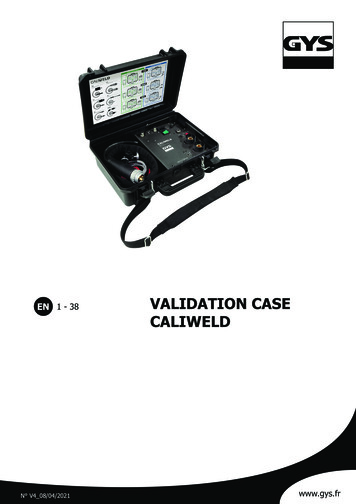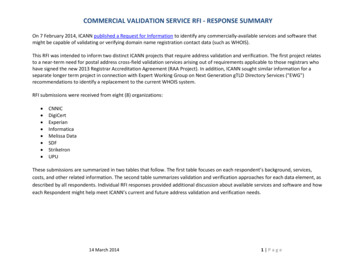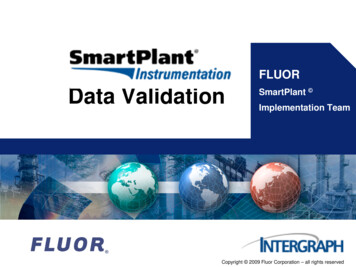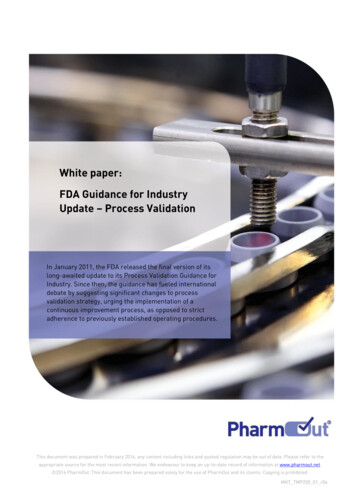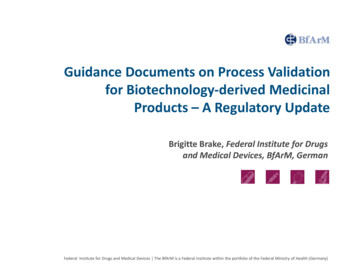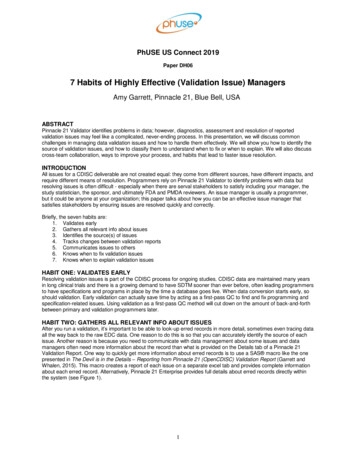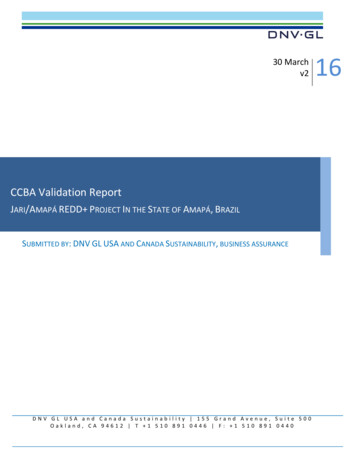
Transcription
APTEFF, 42, 1-288 (2011)DOI: 10.2298/APT1142011DUDC: 543.422.7:546.18:631.576.3BIBLID: 1450-7188 (2011) 42, 11-21Original scientific paperVALIDATION STUDY OF A RAPID COLORIMETRIC METHOD FOR THEDETERMINATION OF PHYTIC ACID AND INORGANIC PHOSPHORUSFROM SEEDSVesna D. Dragiĉević*, Slobodanka D. Sredojević, Vesna A. Perić, Anika R. Nišavić andMirjana B. Srebrić Maize Research Institute „Zemun Polje“, Slobodana Bajiša 1, 11185 Belgrade-Zemun, SerbiaPhytate, as an important mineral storage compound in seeds, is vital for seed/graindevelopment; it is often considered to be an antinutritional substance. The objective ofthis study was to develop a rapid and inexpensive colorimetric method of measuring phytate and inorganic P (Pi) concentrations from maize, soybean and sunflower seed/grainextracts, by combining adequate precision and simplicity, ideal for breeders interested inimproving simultaneously Pi and phytate levels. The investigated extraction mediums:double distilled (DD) H2O, 2.4 % HCl and 5 % trichloracetic acid (TCA) were proved tobe suitable for the analysis of phytic acid and inorganic phosphorus in seed extracts. Theadvantages of 5 % TCA over to DD H2O and 2.4 % HCl were reflected through the lowlimit of detection for both phytic acid and P i and good recovery with low bias. A low detection limit for Pi is important for samples with naturally low Pi concentrations, such assoybean seeds.KEY WORDS: phytic acid, inorganic phosphorus, seed, validationINTRODUCTIONA very important mineral storage compound in seeds is phytate, a mixed cation salt ofphytic acid (myo-inositol hexakis phosphoric acid). This compound is important forseveral reasons: it is vital for seed/grain development and successful seedling growth; itis often considered to be an antinutritional substance in diets, but it may have a nutritionalrole as an anti-oxidant agent; it represents a very significant amount of phosphorus beingextracted from soils, and plays a role in eutrophication of waterways (1). Phosphorusbound in phytate is nutritionally unavailable to monogastric animals. Also, phytate canchelate certain minerals and exacerbate human mineral deficiencies.In plant seed physiology, a novel role was assigned to phytic acid, i.e., as protectionagainst oxidative stress during the seed's life span. As in maize kernels, the greater part ofphytic acid (and thus of metal ions) is concentrated in the embryo; thus its antioxidantaction may be of particular relevance in this crop (2). Phytic acid and its derivatives are* Corresponding author: Vesna D. Dragiţeviš, Maize Research Institute „Zemun Polje“, Slobodana Bajiša 1,11185 Belgrade-Zemun, Serbia, e-mail: vdragicevic@mrizp.rs11
APTEFF, 42, 1-288 (2011)DOI: 10.2298/APT1142011DUDC: 543.422.7:546.18:631.576.3BIBLID: 1450-7188 (2011) 42, 11-21Original scientific paperalso implicated in RNA export, DNA repair, signalling, endocytosis, and cell vesiculartrafficking (3). Phytate has an important antioxidant function in seeds during dormancyand it may be a substitute for the presently employed preservatives, many of which posepotential health hazards (4).Our primary objective was to develop a rapid and inexpensive method for measuringphytate and inorganic P (Pi) concentrations in maize, soybean and sunflower grain. Thecombination of adequate precision and simplicity make the proposed method ideal forbreeders interested in simultaneously improving Pi and phytate levels. Gas chromatography determinations show better sensitivity (5), but the analytical procedure lasts long.Also, suppressed conductivity, ion chromatography (6) had linearity over a wider range,with low detection limits for phytic acid and Pi. Veliţkoviš et al. (7) underlined theadvantage of methods requiring reduced amounts of sample and reagents, with shorterextraction times, with no significant influence on accuracy.Presently, most assays for phytic acid employ ferric chloride to precipitate ferricphytate. The precipitate may be digested and analyzed for either phosphorus or iron.Alternatively, sodium hydroxide may be used to convert the precipitate to sodium phytateand ferric hydroxide. It is convenient to analyze for iron after taking up ferric hydroxidein acid. Determination of residual iron or phosphorus in the supernatant after precipitation is also a rapid method (8). The addition of orthophosphate (up to 20 μg/ml of phosphorus) and chlorogenic acid (up to 50 μg/ml) does not impair the colorimetric assay ofphytate based on the decolouration of the Fe3 -sulphosalicylate complex (9).The intention of this study was to readjust the colorimetric analytical procedure forphytic acid and inorganic phosphorus determination from the same seed extract, and tosimplify and accelerate it for the analysis of a large number of samples.EXPERIMENTALPreparation of samplesThe seeds of four maize hybrids (ZPSC 704; ZPSC 836; ZPSC 341; ZPSC 666), fivesoybean varieties (Lidija; Olga; ZP 015; Lana; Nena) and five sunflower lines (KOZ/11;L/4/RU/4; PP/34; ALV/12; AZ/20) were ground in a Tecator Knifetec 1095 sample mill.The obstruction in the analytical procedure, due to the relatively high lipid contents insoybean and sunflower seeds, was surpassed by their removal by extraction withpetroleum ether (40–60 C) during 14 hours, similar to the gas-chromatography procedure(5). Thus, the lipids were removed from soybean and sunflower flour.Reagents and standardsThe following reagents were used for the extraction of phytic acid and inorganicphosphorus: double distilled (DD) H2O, 2.4 % HCl and 5 % trichloroacetic acid (TCA).The following reagents for determination were used for phytic acid: Wade reagent 0.3 gFeCl3 6H2O 3 g 5‟-sulphosalicylic acid in one litre (this reagent can be stored for a longtime in a dark bottle), and the reagent for inorganic phosphorus determination: 30 g of12
APTEFF, 42, 1-288 (2011)DOI: 10.2298/APT1142011DUDC: 543.422.7:546.18:631.576.3BIBLID: 1450-7188 (2011) 42, 11-21Original scientific paperammonium heptamolybdate was dissolved in 500 mL of DD H2O at 60 C; 0.75 g ofammonium metavanadate was dissolved in 300 mL DD H2O, after cooling 150 mL ofHNO3 was added and then the resulting solution was made up 500 mL with DD H20. Theammonium heptamolybdate solution is then added with slow stirring into the ammoniummetavanadate solution. Stock standard solutions: phytic acid (dodecasodium salt, frommaize, Sigma P-8810) was made up to 200 mL DD H2O (the concentration of phytic acidin the solution was 0.5 mg mL–1) and KH2PO4 (Sigma P-5379) was made up to 50 mLDD H2O (the concentration of phosphorus in the solution was 0.25 mg P 2O5 mL–1) andseveral drops of chloroform were added.A series of standard phytic acid solutions was made from the stock standard solutionby appropriate dilutions, with addition of extraction solutions, to simulate conditionssimilar to those in the samples: 17 mL of 5 % TCA or 6 mL of 2.4 % HCl. The concentrations of phytic acid in this series were as follows: 1; 5, 10; 15; 20; 25; 30; 35; 40 µmol100 mL–1. A series of standard inorganic phosphorus (Pi) solutions was made from thestock standard solution by appropriate dilutions to give the concentrations: 7.7; 15.5;23.2; 31.0; 38.7; 45.5; 54.2; 62.0; 69.7; 77.4 nmol P 2O5 100 mL–1, with appropriate addition of extraction solutions: 50 mL of 5 % TCA or 2.4 % HCl (for maize and soybean), or3 mL of extraction solution (for sunflower).Extraction of phytic acidA meal sample (0.25 g) was placed in an extraction flask and 10 mL of extractionsolution was added. The flask was stoppered and shaken for 1 h on a mechanical shaker.Kwanyuen and Burton (10) obtained the best results with 1 h extraction of phytate fromsoybean meal. 5 mL of the extract were placed into a centrifuge tube and then centrifugedon an Eppendorf Centrifuge 5417R at 12,000 g for 15 minutes at 4 C. The methodprecision was tested by the spike procedure, with the addition of 0.75 ml of phytic acidstock or 50 µL of KH2PO4 stock to 5 mL of sample, before centrifuging. Six replicateswere performed in all cases.Colorimetric determination of the PA and P i contentsThe supernatant was diluted to an appropriate concentration suitable for the analysis;for the phytic acid determinations the dilution was 1:5 for maize, 1:16 for soybean and1:30 for sunflower; for the Pi determinations, the dilutions were 1:1 for maize and soybean and 1:30 for sunflower. Then, to 1.5 mL aliquots of Wade reagent was added 0.5mL for PA determination, or to 2 mL aliquots 0.5 mL of Pi reagent (ammonium heptamolybdate ammonium metavanadate). Subsequently, the samples were centrifuged at12,000 g for 10 minutes. The absorbance was read on a Shimadzu SpectrophotometerUV-1601, at λ 500 nm for phytic acid and λ 400 nm for Pi.Minitab 14 (Minitab, 2004) was used for all statistical and graphical analyses.13
APTEFF, 42, 1-288 (2011)DOI: 10.2298/APT1142011DUDC: 543.422.7:546.18:631.576.3BIBLID: 1450-7188 (2011) 42, 11-21Original scientific paperRESULTS AND DISCUSSIONThe lowest detection limit for PA (Table 1), with a low variation between the batches,was obtained with DD H2O as the extraction medium. The lowest detection limit forinorganic phosphorus was obtained with 5 % TCA, but smaller variations were found forthe DD H2O batches. The obtained detection limits for PA and Pi are lower than thosefound using suppressed conductivity ion chromatography (6), where the detection limitsfor PA and Pi were 3.5 and 1.5 mg L-1. Kikunaga et al. (12) denoted that detection limitfor PA from small grain cereals, by using of HCl as extraction medium was 0.025 µmolmL-1, while Gao et al. (13) found that the detection range for PA from soybean mealdepends on applied method: for colorimetric method it was 1.91-6.20 mg g-1, for anionexchange column 1.35-7.28 mg g-1, for HPLC 1.02-5.92 mg g-1. It could be assumed thathigh acidity of the media provided for protein precipitation (12; 14), which could obstructthe later analytical procedure and could be crucial for soybean and sunflower seeds,which are rich in proteins. The use of an adequate amount of a suitable extraction medium reduced the extraction process to only 1 hour, which accelerated the analyticalprocess compared to the method of Lorenz et al. (14), in which the extraction procedurelasted about 12 hours. The results obtained by Joţiš (11) showed that multiple extractionof PA with 5 % TCA from maize meal is unnecessary and that 1 hour is sufficient toextract most of the PA from the maize meal. PA insoluble in water makes only 2.304.70% of total PA amount, while it is fully extracted with TCA as extraction medium.Table 1. Limits of detection of phytic acid (PA) and inorganic phosphorus (P i) indifferent extraction mediumsDD H2O5 % TCA2.4 % HClPA / µmol ml-1 SD0.00307 0.000190.00416 0.000250.00926 0.00056Pi / nmol ml-1 SD0.00069 0.000140.00024 0.0000480.00026 0.000053The results of the linearity test for PA indicated that the standard curve was linear inthe range of 0.05 – 0.30 µmol phytic acid ml–1 for DD H2O and 5 % TCA as the extraction media (Figure 1), with a higher slope of 1.030 obtained using the TCA medium.A similar situation was present for the linearity test for Pi, for which the standard curvewas linear in the range of 0.077 – 0.387 nmol P2O5 ml–1 for DD H2O and 5 % TCA, withno remarkable difference in the slope value. Only the standard curves obtained when 2.4% HCl was used as the extraction medium were linear in the ranges 0.05 – 0.20 µmol PAml–1 and 0.155 – 0.387 nmol P2O5 ml–1, which made this medium inapplicable for the Pidetermination in samples with a low Pi content, such as in maize seeds.14
APTEFF, 42, 1-288 (2011)DOI: 10.2298/APT1142011DUDC: 543.422.7:546.18:631.576.3BIBLID: 1450-7188 (2011) 42, 11-21Original scientific paperFigure 1. The linearity test of standard curve for phytic acid (A) and Pi (B) determinationin DD H2O, 5 % TCA and 2.4 % HCl, as extraction mediumsTable 2. Method accuracy for phytic acid determination in maize seed‟s extract, usingDD H2O and 5 % TCA as extraction mediumsSampleDD H2O5% TCAZPSC 704ZPSC 836ZPSC 341ZPSC 666ZPSC 704ZPSC 836ZPSC 341ZPSC 666Nominal value*(nmol 386Recoveryrange (%)98 - 10499 - 10297 - 10398 - 10398 - 10096 - 10099 - 10199 - .923.480.870.652.281.701.041.67* Least significant difference, Student‟s T-test, P 0.05 (LSD 0.0946)Coefficient of variationa15
APTEFF, 42, 1-288 (2011)DOI: 10.2298/APT1142011DUDC: 543.422.7:546.18:631.576.3BIBLID: 1450-7188 (2011) 42, 11-21Original scientific paperThe accuracy achieved by an analytical method is often evaluated by calculating thevalue for recovery, bias, and coefficient of variation. The results presented in Tables 2and 3 indicate that there were no significant differences between the values of the contentof PA and Pi in the maize sample extracts obtained using f DD H2O and 5 % TCA. ThePA amount in the DD H2O extracts was 0.1237 – 0.3457 µmol ml–1, while in the TCAextracts it was 0.1014 – 0.3427 µmol ml–1 (Table 2). Joţiš (11) ascertained that there wasno significant difference in the amount of PA soluble in DD H2O and 5 % TCA extractedfrom maize seeds. The same author obtained 1.42-2.87 mg of total PA per maize seed byTCA extraction, while it was 1.25-2.84 mg of total PA per maize seed by extraction withdeionised water. The Pi amount in the DD H2O extracts was 9.385 – 17.458 nmol ml–1,while in the TCA extracts it was 10.120 – 17.594 nmol ml–1 (Table 3).Table 3. Method accuracy for Pi determination in maize seed‟s extract, using DD H2Oand 5 % TCA as extraction mediumsSampleDD H2O5% TCAZPSC 704ZPSC 836ZPSC 341ZPSC 666ZPSC 704ZPSC 836ZPSC 341ZPSC 666Nominal value*(nmol 00Recovery range(%)98 – 10196 – 10297 – 10098 - 104100 – 10199 - 10199 - 101100 - .042.003.522.911.552.002.721.60* Least significant difference, Student‟s T-test, P 0.05 (LSD 2.397)Coefficient of variationaThe differences between the samples, i.e., maize hybrids, in terms of PA and Picontents indicated that early maturity groups, i.e., smaller size seeds (such as ZPSC 341)had a higher PA content and vice versa, a lower Pi content, which is in agreement withexperimental data of other authors (14). The values of the recovery range, closest to 100%, as well as the lowest variations between sample replications for PA and Pi, indicatethat 5 % TCA was a better extraction medium for maize seeds, irrespective of the factthat bias values were negligibly higher for PA when 5 % TCA was used as the extractionmedium. It is important to emphasise that 2.4 % HCl was not an appropriate extractionmedium for PA extraction from maize seeds, without neutralisation, which could prolongthe analytic process.The amount of PA in the DD H2O extracts of soybean was 0.0135-0.0173 µmol ml–1,and in the TCA extracts, it was 0.0139 – 0.0172 µmol ml–1, while in the HCl extracts thevalues were higher, 0.069-0.0210 µmol ml–1 (Table 4).16
APTEFF, 42, 1-288 (2011)DOI: 10.2298/APT1142011DUDC: 543.422.7:546.18:631.576.3BIBLID: 1450-7188 (2011) 42, 11-21Original scientific paperTable 4. Method accuracy for phytic acid determination in soybean seed‟s extract, usingDD H2O, 5 % TCA and 2.4 % HCl as extraction mediums2.4% HCl5% TCADD H2OSampleLidijaOlgaZP 015LanaNenaLidijaOlgaZP 015LanaNenaLidijaOlgaZP 015LanaNenaNominal value*(nmol ery range(%)99 – 10299 – 101100 – 102100 – 10199 - 10299 – 10297 – 10297 - 10299 – 10198 - 10168 – 11584 – 12575 – 11597 – 10574 - .623.722.692.273.404.576.175.125.275.45* Least significant difference, Student‟s T-test, P 0.05 (LSD 0.0158)aCoefficient of variationUsing all three extraction media for phytic acid extraction from soybean seeds indicated a statistically significant higher PA content in the samples of the Lidija variety when2.4 % HCl was employed as extraction medium. It is also noticeable that the soybeanHCl extracts had the highest range of recovery of 68 – 115%, with a high bias and variation between the batches. Moreover, the Pi determination from soybean by using of DDH2O as the extraction medium could not be performed because of the precipitation causedby the high acidity of the reagent used for P2O5 analysis, which was hard to remove bycentrifugation.The Pi amount in the soybean TCA extracts was 0.0064 – 0.0090 nmol ml–1, while itin the HCl extracts was 0.0047 – 0.0066 nmol ml–1 (Table 5). There was no statisticaldifference between the Pi values found in the extracts obtained using of 5 % TCA and 2.4% HCl. Considering recovery, the best values were obtained using DD H2O as theextraction medium for PA (99 – 102 %, Table 4) and using 5 % TCA for Pi extraction (98– 103 %, Table 5). It was also noticeable that the bias values for both PA and Pi were thelowest in the TCA extracts and they were in the range of 0.06 – 0.73 for PA and 0.004 –3.96 for Pi. Furthermore, the coefficient of variation for the TCA extracts was below 5 %,with the exception of that with the soybean variety Olga, where it was 5.05 %.17
APTEFF, 42, 1-288 (2011)DOI: 10.2298/APT1142011DUDC: 543.422.7:546.18:631.576.3BIBLID: 1450-7188 (2011) 42, 11-21Original scientific paperTable 5. Method accuracy for Pi determination in soybean seed‟s extract, using 5 % TCAand 2.4 % HCl as extraction mediums2.4% HCl5% TCASampleLidijaOlgaZP 015LanaNenaLidijaOlgaZP 015LanaNenaNominal value*(nmol 0470.0053*0.0040Recovery range(%)99 – 10398 – 101100 – 10298 – 10298 - 10185 – 8984 – 9580 – 9695 - 10291 - * Least significant difference, Student‟s T-test, P 0.05 (LSD 0.0025)aCoefficient of variationOwing to the high dilution of the sunflower seed extracts, relatively low PA valueswere obtained, 0.0264 – 0.0341 µmol ml–1, in the TCA extracts and 0.0287 – 0.0348µmol ml–1 in the HCl extracts (Table 6), with no significant difference between the extraction media. A better recovery, of 99 – 100 %, and bias values below 1 (with theexception of the extracts of the variety AZ/20, for which the value was 1.44) showed that5 % TCA was a better extraction medium. The coefficients of variation for the measurements obtained using 5 % TCA as the extraction medium were somewhat higher compared to those obtained using 2.4 % HCl. However, they also indicate good precision forboth extraction media, since all of the values obtained were below 5 %. A high dilution ofthe sunflower extracts was also important for good precision of the Pi analysis. Dilutingand pH buffering of the extracts may improve the results, since the recovery of phytatewas increased when the extract pH was closer to 6.0 (9).Table 6. Method accuracy for phytic acid determination in sunflower seed‟s extract,using 5 % TCA and 2.4 % HCl as extraction mediums2.4% HCl5% U/4PP/34ALV/12AZ/20Nominal value*(nmol 2990.03100.0287Recovery range(%)100 – 10299 – 10099 – 10299 – 10299 - 10296 – 10998 – 10697 – 10088 – 10689 - 107* Least significant difference, Student‟s T-test, P 0.05 (LSD 0.1168)a18Coefficient of 85
APTEFF, 42, 1-288 (2011)DOI: 10.2298/APT1142011DUDC: 543.422.7:546.18:631.576.3BIBLID: 1450-7188 (2011) 42, 11-21Original scientific paperTable 7. Method accuracy for Pi determination in sunflower seed‟s extract, using 5 %TCA and 2.4 % HCl as extraction mediums2.4% HCl5% U/4PP/34ALV/12AZ/20Nominal value*(nmol 0310.00340.0035Recovery range(%)99 – 10198 – 10199 – 10299 – 10199 - 10199 – 10299 – 10199 – 10897 – 10498 - a(%)2.312.741.712.044.271.082.052.831.292.12* Least significant difference, Student‟s T-test, P 0.05 (LSD 0.0225)aCoefficient of variationBesides, there was no statistical difference between the values of the Pi content in theTCA and HCl extracts; they were 0.0026 – 0.0031 nmol ml–1 in the TCA extracts and0.0027 – 0.0035 nmol ml–1 in the HCl extracts (Table 7). Recovery values in the range of99 – 102 %, as well as the bias values under 1, showed that 5 % TCA was a better extraction medium, irrespective of the lower coefficients of variation obtained in the samples obtained with 2.4 % HCl.CONCLUSIONThe investigated extraction media proved to be suitable for the determination of thePA and Pi contents in maize, soybean and sunflower seeds. The advantages of 5 % TCAfor the seeds of all three examined species over DD H2O and 2.4 % HCl, were reflectedthrough the low limit of detection for PA and Pi, and good recovery with low bias values.A low limit of detection for Pi is important for the samples which naturally have low Pilevels, such as soybean seeds. The negligibly lower coefficients of variation obtained forthe HCl extracts of sunflower seeds, in comparison to the TCA extracts could be overcome by increasing the number of replicates, which could be alternatively consideredbecause the coefficients of variations for both extraction media were below 5 %.AcknowledgementThis research was supported by the Ministry of Science and Technological Development of the Republic of Serbia, through Project TR-31037.19
APTEFF, 42, 1-288 (2011)DOI: 10.2298/APT1142011DUDC: 543.422.7:546.18:631.576.3BIBLID: 1450-7188 (2011) 42, 11-21Original scientific paperREFERENCES1. Lott, J.N.A., Ockenden, I., Raboy, V. and Batten, G.D.: Phytic acid and Phosphorusin Crop Seeds and Fruits: A Global Estimate. Seed Sci. Res. 10 (2000) 11-33.2. Doria, E., Galleschi, L., Calucci, L., Pinzino, C., Pilu, R., Cassani E. and Nielsen, E.:Phytic Acid Prevents Oxidative Stress in Seeds: Evidence From a Maize (Zea maysL.) Low Phytic Acid Mutant. J. Exp. Bot. 60 (2009) 967-978.3. Bohn, L., Meyer, A.S. and Rasmussen, S.K.: Phytate: Impact on Environment andHuman Nutrition. A Challenge for Molecular Breeding. J. Zhejiang Univ. Sci. B 9(2008) 165-191.4. Graf, E.S., Empson, K.L. and Eaton, J.W.: Phytic acid. A Natural Antioxidant. JBC262 (1987) 11647-11650.5. March, J.G., Simonet, B.M. and Grases, F.: Determination of Phytic Acid by GasChromatography–Mass Spectroscopy: Application to Biological Samples. J. Chromatogr. B 757 (2001) 247-255.6. Liu, Q., Dong, W., Shi, Q. and Yang, G.: Determination of Phytate and Phosphate inPlant Samples by Suppressed Conductivity Ion Hromatography. Se Pu 23 (2005) 302304.7. Velickovic D., Vucelic-Radovic, B., Blagojevic, S., Barac, M., Stanojevic, S. andLjubicic, M.: A Modification of a Method for Phytic Acid Determination. J. Serb.Chem. Soc. 64 (1999) 303-310.8. Thompson, D.B. and Erdman, J.W. JR.: Phytic Acid Determination in Soybeans. J.Food Sci. 47 (1982) 513-517.9. Vaintraub, I.A. and Lapteva, N.A.: Colorimetric Determination of Phytate in Unpurified Extracts of Seeds and the Products of Their Processing. Anal. Biochem. 175(1988) 227-230.10. Kwanyuen, P. and Burton, J.W.: A Simple and Rapid Procedure for Phytate Determination in Soybean and Soybean Products. JAOCS 82 (2005) 81-85.11. Joţiš, N. : Ispitivanje sadrţaja rastvorljivog fitina u semenu kukuruza F1 generacije ufazi mirovanja. Specijalistiţki rad, Hemijski fakultet Univerziteta u Beogradu, 1995.12. Kikunaga, S., Takahashi, M. and Huzisige, H.: Accurate and Simple Measurement ofPhytic acid Contents in Cereal Grains. Plant Cell Physiol. 26 (1985) 1323-1330.13. Gao, Y., Shang, C., Saghai Maroof, M.A., Biyashev, R.M., Grabau, E.A., Kwanyuen,P., Burton, J.W. and Buss, G.R.: A Modified Colorimetric Method for phytic AcidAnalysis in Soybean. Crop Sci. 47 (2007) 1797-1803.14. Lorenz, A.J., Scott, M.P. and Lamkey, K.R.: Quantitative Determination of Phytateand Inorganic Phosphorus for Maize Breeding. Crop Sci. 47 (2007) 600-606.20
APTEFF, 42, 1-288 (2011)DOI: 10.2298/APT1142011DUDC: 543.422.7:546.18:631.576.3BIBLID: 1450-7188 (2011) 42, 11-21Original scientific paperСТУДИЈА ВАЛИДАЦИЈЕ БРЗЕ КОЛОРИМЕТРИЈСКЕ МЕТОДЕ ЗАОДРЕЂИВАЊЕ ФИТИНСКЕ КИСЕЛИНЕ И НЕОРГАНСКОГ ФОСФОРА УСЕМЕНУВесна Д. Драгичевић, Слободанка Д. Средојевић, Весна A. Перић, Аника P. Нишавићи Мирјана Б. СребрићИнститут за кукуруз „Земун Поље“, Слободана Бајића 1, 11185 Београд-Земун, СрбијаФитат је важан за развој семена и служи за складиштење минерала. Он сеуглавном сматра за антинутритивну супстанцу. Циљ истраживања је био да серазвије брза и јефтина колориметријска метода за мерење концентрације фитата инеорганског фосфора (Pi) из екстракта семена кукуруза, соје и сунцокрета, комбинујући одређену прецизност и једноставност, идеалне за селекционере заинтересоване за истовремено побољшање односа Pi и фитата у семену. Испитивана екстракциона средства: бидестилована вода (DD H2O), 2,4 % HCl и 5 % трихлорсирћетна киселина (TCA) су се показале погодним за анализу фитинске киселине иPi из екстракта семена. Предност 5 % TCA у односу на DD H2O и 2,4 % HCl сеогледа у ниској граници детекције за фитинску киселину и Pi, добром recovery-ју иниским вредностима одступања (bias). Ниска граница детекције за Pi је важна заузорке са природно ниском Pi концентрацијом, као што је семе соје.Кључне речи: фитинска киселина, неоргански фосфор, семе, валидацијаReceived 11 January 2011Accepted 24 May 201121
It is convenient to analyze for iron after taking up ferric hydroxide in acid. Determination of residual iron or phosphorus in the supernatant after precipita-tion is also a rapid method (8). The addition of orthophosphate (up to 20 μg/ml of phos-phorus) and chlorogenic acid (up to 50 μg/ml) does not impair the colorimetric assay of
